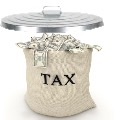- By NYS Comptroller's Office
- News
 Print
Print  The number of school districts overriding New York’s property tax cap declined by more than half over the past three fiscal years, dropping from 44 school districts in 2012-13 to only 19 in 2014-15, according to a report issued today by State Comptroller Thomas P. DiNapoli. The report also found low- and average-need districts were twice as likely to override the tax cap compared to high-need districts.
The number of school districts overriding New York’s property tax cap declined by more than half over the past three fiscal years, dropping from 44 school districts in 2012-13 to only 19 in 2014-15, according to a report issued today by State Comptroller Thomas P. DiNapoli. The report also found low- and average-need districts were twice as likely to override the tax cap compared to high-need districts.“Local school district officials are working hard to operate within the confines of the cap,” said DiNapoli. “As the cap fluctuates below two percent, it becomes increasingly difficult to stay under the levy limit while also dealing with increased costs and uncertain state aid. If the past three years are any indication, however, school districts will continue to hold the line on taxes despite these challenges.”
Overall, 6.5 percent of districts exceeded the tax cap in 2012-13 (44 districts), 4.7 percent (32) in 2013-14 and 2.8 percent (19) in 2014-15. During this three year time frame, a total of 79 school districts exceeded the cap at least once. Fourteen districts exceeded the cap in two of the three years and one district exceeded the cap all three years.
Of the districts exceeding the cap, the report highlighted low-need and average-need districts generally receive less state aid than high-need districts, and therefore were more dependent on property taxes to fund their programs. From 2013-2014 to 2014-2015, 3.3 percent of low- and average-need districts exceeded the cap while only 1.5 percent of high-need districts did so.
DiNapoli’s office also found, based on individual calculations, 363 school districts could have increased the tax levy by more than 2 percent last year and, of these, 62 could have increased the tax levy by 4 percent or more while technically remaining under the cap. In contrast, 69 districts were held to less than a 1 percent increase – with 17 actually being subject to a levy decrease from the prior year.
Nuances in the complex cap calculations have also resulted in some large year-to-year fluctuations for some districts. For example, one district’s allowable levy limit was 21.7 percent less than in the year prior while another district’s allowable levy limit was 45.5 percent higher than in the prior year.
Additional findings in the report include:
- Property taxes are the major revenue source for school districts outside of New York City. In 2013, these school districts spent $37.5 billion, of which $20.5 billion (55 percent) was raised through property taxes;
- School district levies increased each year at a rate slightly less than what was allowed by the tax cap. In 2012-13, school districts consumed 99.6 percent of their available limit, in 2013-14 it was 99.2 percent and in 2014-15 it was 99.7 percent; and
- Of the 19 school districts overriding the tax cap for 2014-15, five were found to be in some level of stress based on the Comptroller’s Fiscal Stress Monitoring System.
v11i7



